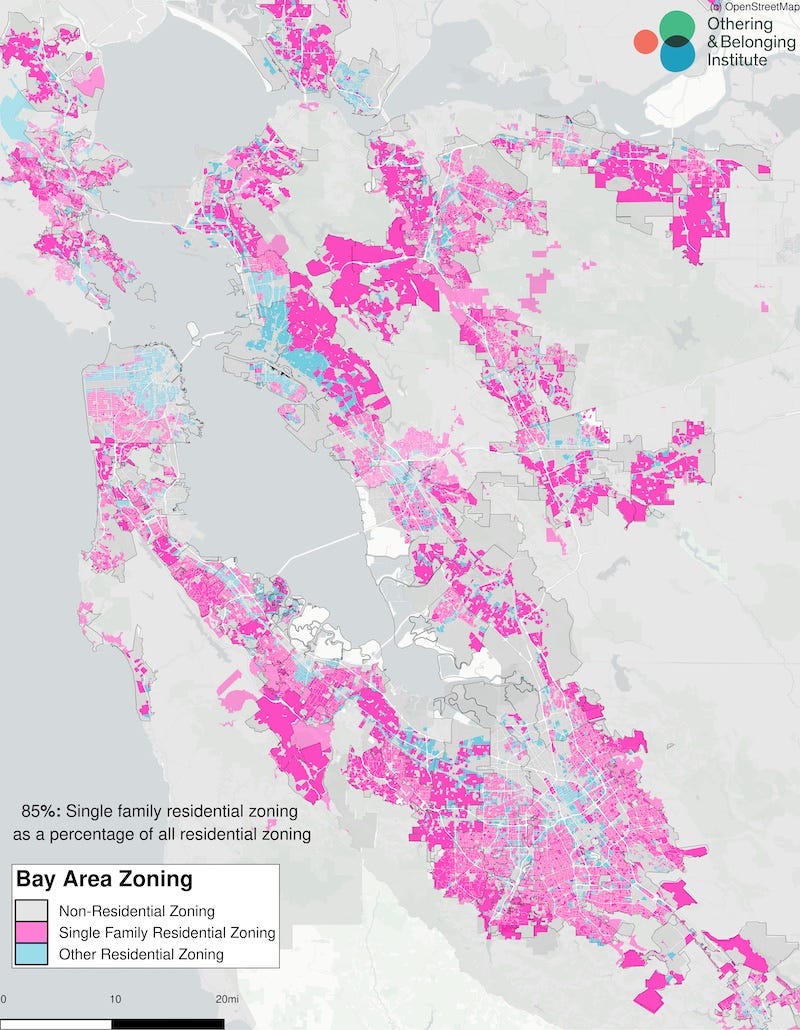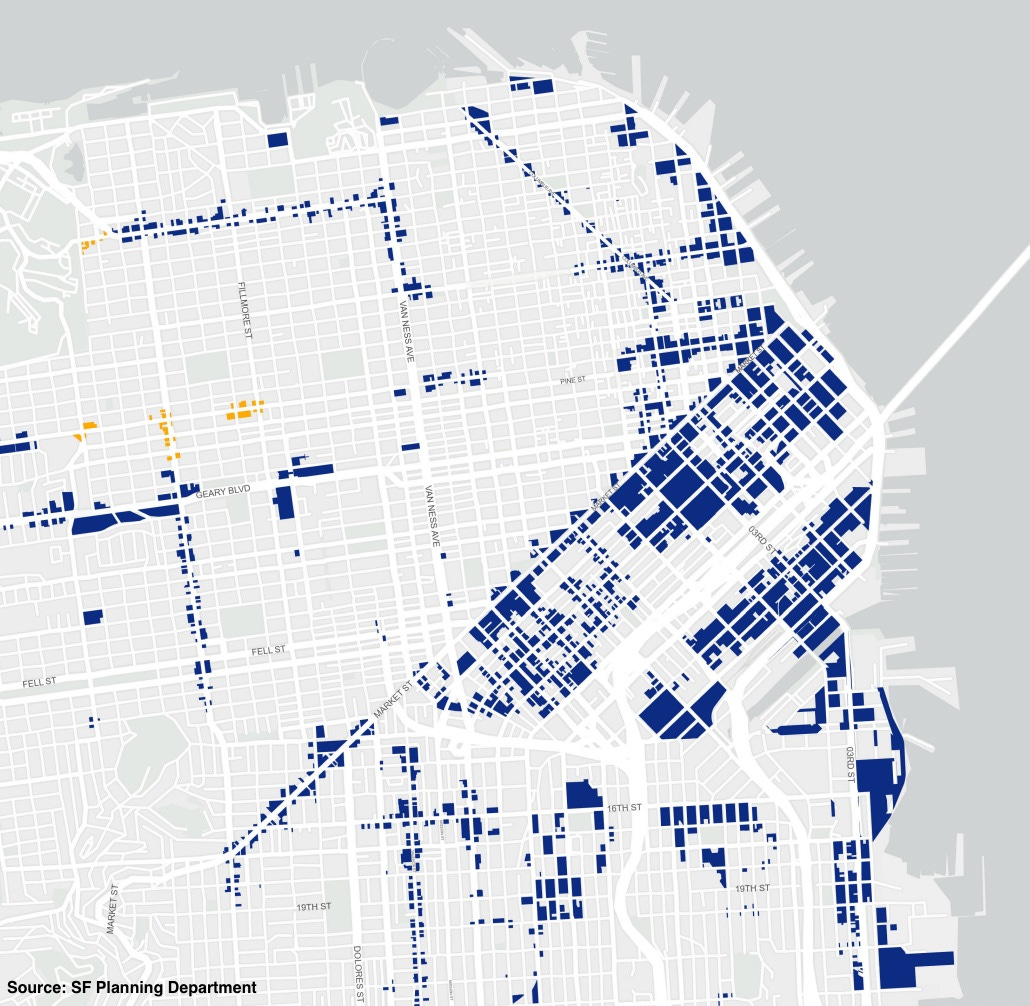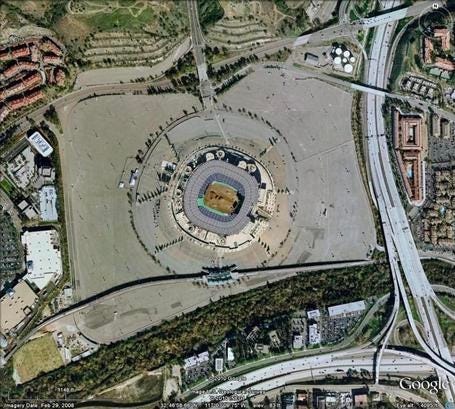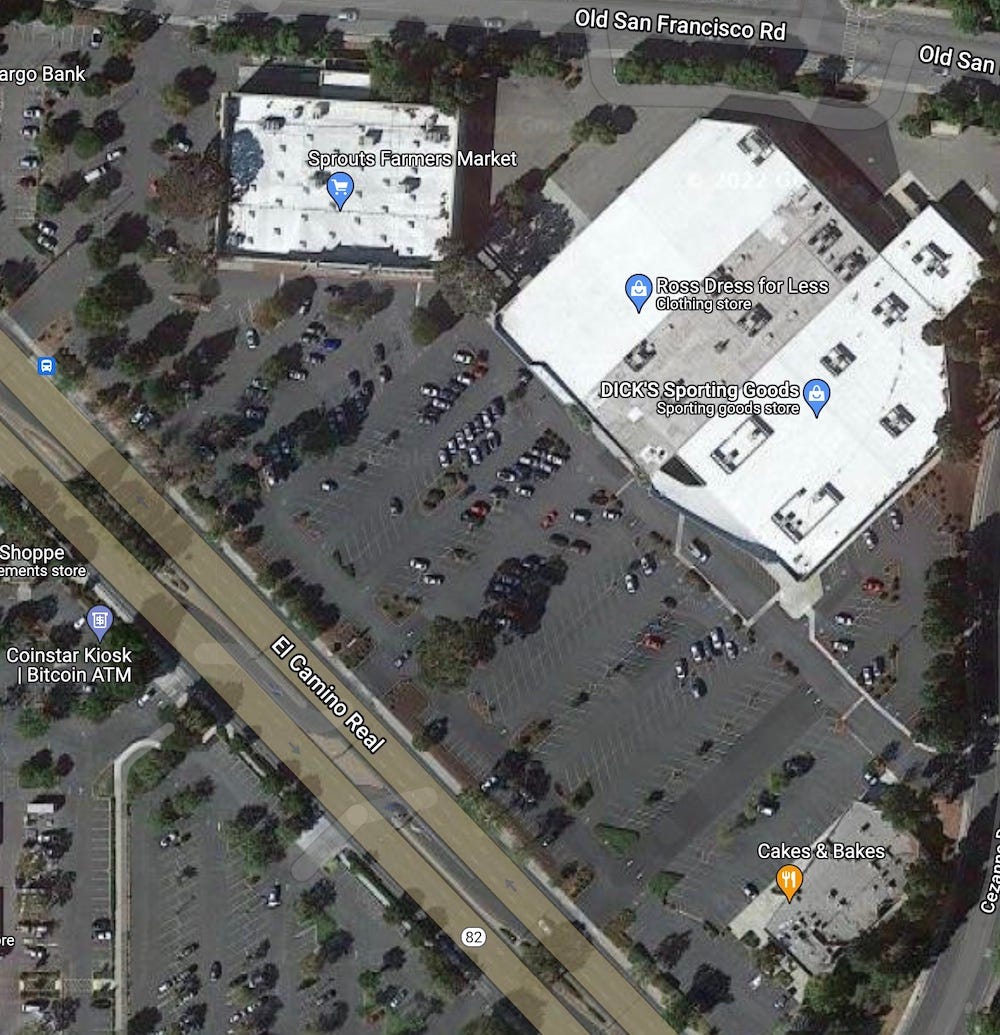It’s time to build housing in California, Part 2: The impact of AB 2011 and AB 2097
Residential developments get a big boost in California
California just signed two big zoning and process reforms in 2022: AB 2011 and AB 2097. Together, they'll increase the supply of housing in key ways: more eligible sites, lower development costs, and clear and predictable development rules.

More eligible sites
Before AB 2011, developers had a hard time finding good sites to build dense housing on. Due to local anti-growth pressure, the majority of residential zoning in California is for low density single family. For example, in the Bay Area, 85% of residential lots are single family.
(source: https://belonging.berkeley.edu/single-family-zoning-san-francisco-bay-area)
Lots zoned for dense residential are largely built out. Redeveloping them into larger buildings has significant costs in acquisition and tenant disruption.
Many sites zoned for commercial uses could be excellent for dense development. They’re in high-demand locations and well served by transit. However, residential use of these sites requires a variance, a land-use exception granted by a local political body. Variances are hard to get, by design. They require political capital, which current residents have but potential future residents do not. Experienced developers are experts at getting variances by trading “community benefits”. But this process is political and opaque, ripe for corruption, and uncertain and impossible to plan for. Variances often become a tool for the connected to cash in on political favors. That’s no way to plan a city.
AB 2011 creates compelling eligible sites that don’t need variances. It overrides local zoning codes to allow dense housing in commercially zoned lots, with clear requirements that developers can plan around. These include:
Commercial corridors. Lots must be on streets that are 70 ft to 150 ft wide, or about 4 to 8 lanes. This requirement is eliminated for 100% affordable projects.
“Missing middle” height and density. Projects can be 3 to 6 stories tall, with a density equivalent to 5-10 units in a typical single family lot. Lots within a half mile of major transit stops get the most allowances.
Affordable units. For mixed-income projects, between 13% and 30% of units are rent capped and reserved for means-tested tenants.
AB 2011’s eligibility is quite broad. As an example, San Francisco’s planning department published a preliminary map of eligible lots for mixed-income projects. It’s striking to imagine that each of these lots—in highly trafficked corridors like Geary Blvd and Market St—could become new, dense housing.
All in all, AB 2011 is expected to create 1.6-2.4M new housing units, of which 300k-400k will be affordable.

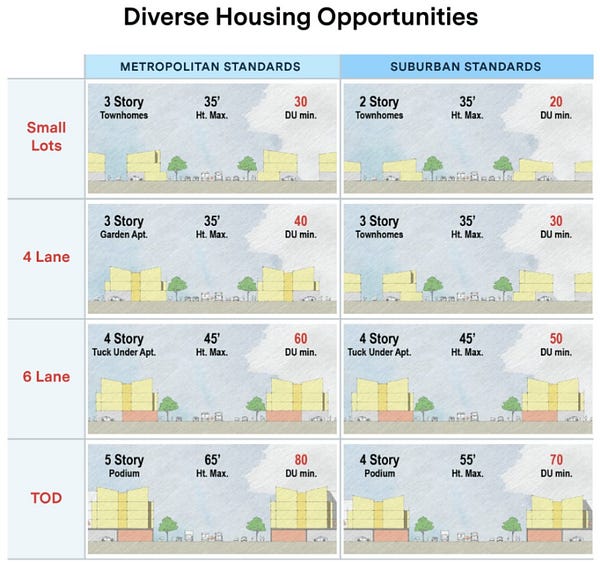

AB 2097 lowers development costs by eliminating minimum parking requirements
Parking requirements may sound mundane, but they loom large in the cost of construction and the type of construction that’s feasible. Required parking often dominates the physical space of construction. Look at some examples of what parking requirements do:
The former Qualcomm (née Jack Murphy) stadium in San Diego is an extreme example. About 94% of the land was dedicated to parking. Stadiums are kind of a worst case. And in fact, that stadium is a rare success story, thanks to San Diego’s forward-leaning housing policies. It is being redeveloped into an extension of the SDSU campus, with lots of housing and transit links replacing a sea of asphalt.
Your everyday strip mall has similar problems. Here’s a typical example in Sunnyvale, California. Less than 35% of the property is actually used by a building.
Of course, people have to actually get to a store. But in transit-rich areas, you can significantly reduce the parking provided — these are significantly overparked.
It’s also important to note that parking isn’t being made illegal, it’s just no longer mandated near transit. That means developers can determine how much parking will be needed, with their knowledge of the specifics of a site.
What’s the impact of all this parking? CA YIMBY reports that parking adds about $40,000 in construction costs per space to housing. A lot of that is the opportunity cost of not being able to build actual housing instead.
That extra cost is substantial, and is ultimately borne by the home renter or buyer.
AB 2011 sets clear and consistent development rules
AB 2011 projects bypass Discretionary Review. Issuance of a development permit requires either a “discretionary” or “ministerial” review by local planners. Discretionary review can be arbitrary and capricious. A project might be killed because a committee member with no architectural training dislikes a design element, or pretends to. Or a local ballot initiative ca be used to kill an approved 60-unit affordable senior housing project, resulting in 16 $5M homes being built instead . The uncertainty and delays while the different constituencies battle it out, add massive risk and cost to projects.
By contrast, ministerial review is objective and can be described in a checklist. Developers using AB 2011 and similar regulations can know exactly what standards they have to follow. As long as developers follow the standards, they have confidence that their projects will be approved. There’s still a lot of nuance and detail required, but the process is inherently streamlined.
AB 2011 projects are exempt from CEQA. CEQA is California’s environmental protection law. It requires extensive ****documentation and mitigation of environmental concerns, real or imagined. CEQA was signed in the 1970’s as a way to give citizens a voice in shaping projects with environmental impact. It’s now one of the most effective anti-growth tools, often abused to extract wage concessions or maintain exclusivity of wealthy neighborhoods. CEQA reports can add years and arbitrary costs to projects, which deter developers from ever attempting them. Exempting transit-friendly housing developments from CEQA removes this potent and misused tool from the NIMBY toolbox.
Summary
In the coming years, California will get a lot of new housing thanks to legislation signed today and in the past few weeks. Much of it will be in under-used commercial lots, in the heart of vibrant and in-demand neighborhoods. Reserved parking will fit the local demand, encouraging walking, biking and transit use. Developments will still be expensive and risky, but an entire category of discretionary and environmental reviews will be skipped. It's time to build that future!



